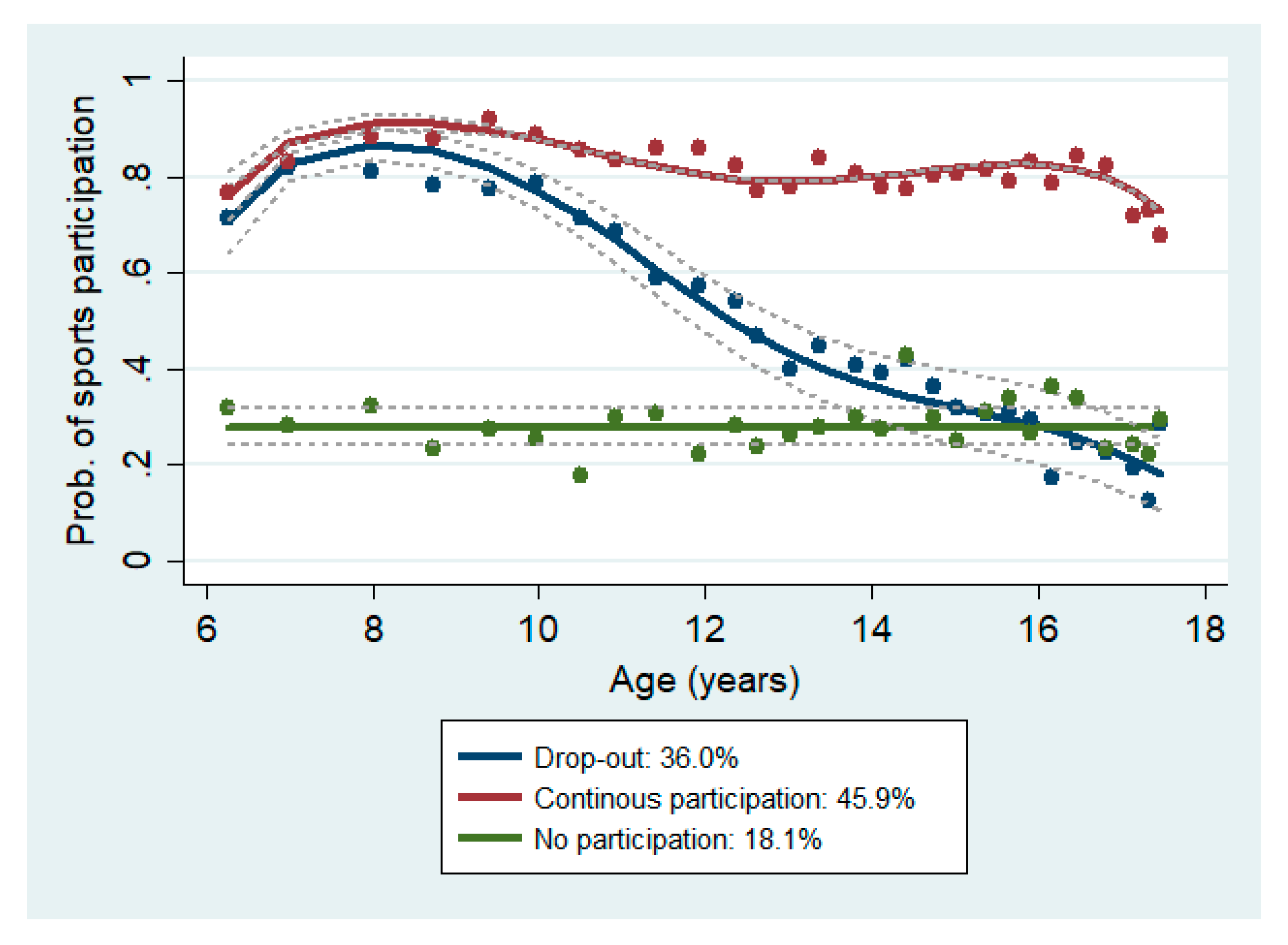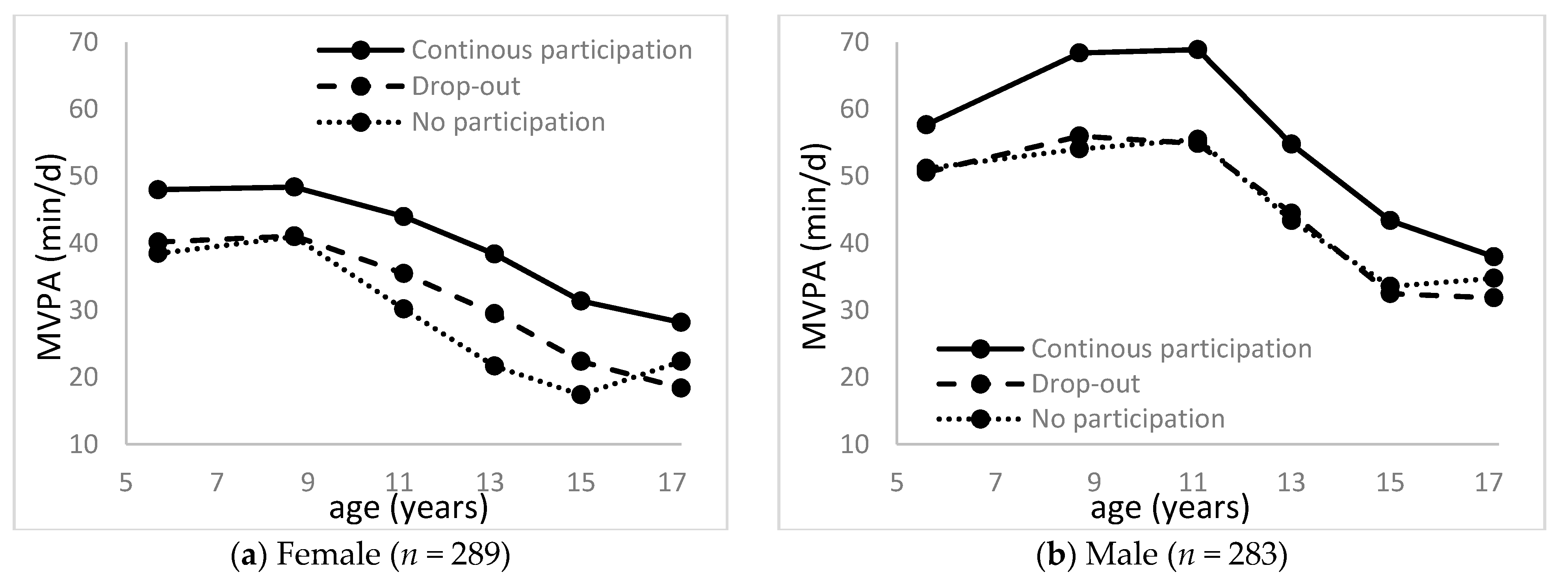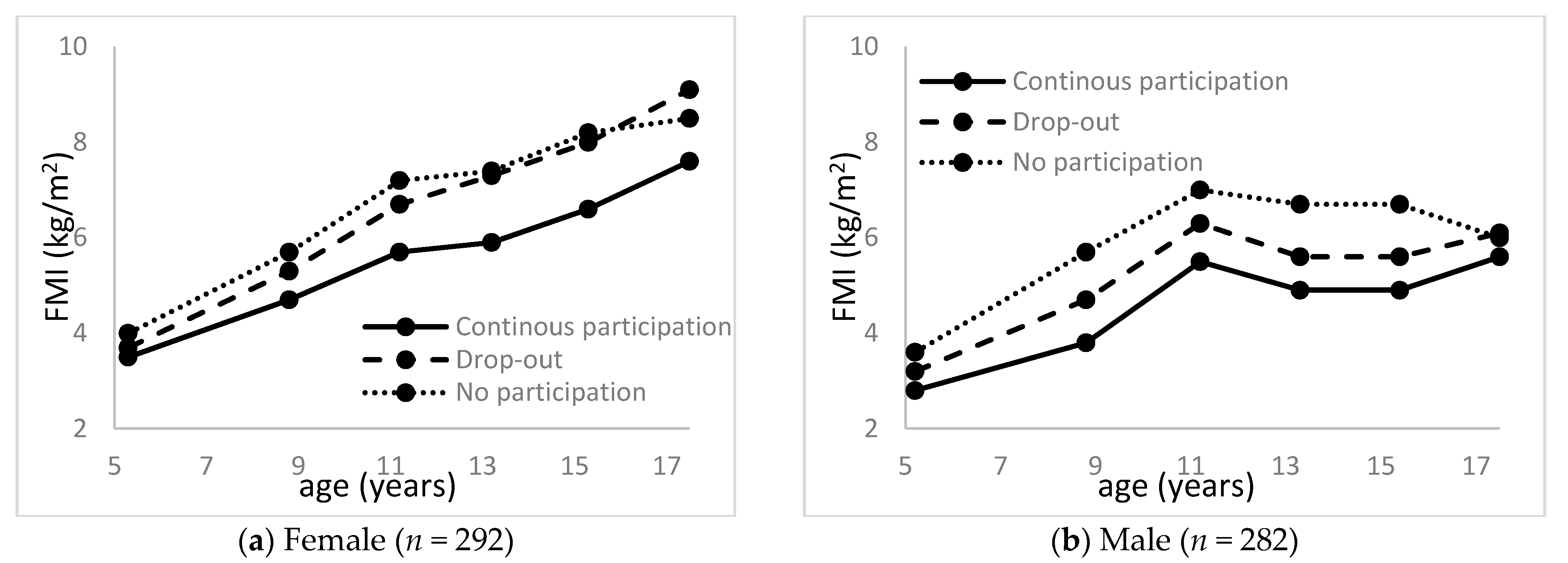Youth Sports Participation Is More Important among Females than Males for Predicting Physical Activity in Early Adulthood: Iowa Bone Development Study
Abstract
1. Introduction
2. Methods
2.1. Study Sample
2.2. Measurements
2.2.1. Sports Participation
2.2.2. Accelerometry
2.2.3. Dual-Energy X-ray Absorptiometry (DXA)
2.2.4. Other Measurements
2.3. Statistical Analysis
3. Results
4. Discussion
Author Contributions
Funding
Institutional Review Board Statement
Informed Consent Statement
Conflicts of Interest
References
- The 2018 Physical Activity Guidelines Advisory Committee. 2018 Physical Activity Guidelines Advisory Committee Scientific Report; U.S. Department of Health and Human Services: Washington, DC, USA, 2018.
- Troiano, R.P.; Berrigan, D.; Dodd, K.W.; Masse, L.C.; Tilert, T.; McDowell, M. Physical activity in the United States measured by accelerometer. Med. Sci. Sports Exerc. 2008, 40, 181–188. [Google Scholar] [CrossRef] [PubMed]
- Pate, R.R.; O’Neill, J.R.; Brown, W.H.; Pfeiffer, K.A.; Dowda, M.; Addy, C.L. Prevalence of Compliance with a New Physical Activity Guideline for Preschool-Age Children. Child. Obes. 2015, 11, 415–420. [Google Scholar] [CrossRef] [PubMed]
- U.S. Department of Health and Human Services. National Youth Sports Strategy; U.S. Department of Health and Human Services: Washington, DC, USA, 2019.
- Hyde, E.T.; Omura, J.D.; Fulton, J.E.; Lee, S.M.; Piercy, K.L.; Carlson, S.A. Disparities in Youth Sports Participation in the U.S., 2017–2018. Am. J. Prev. Med. 2020, 59, e207–e210. [Google Scholar] [CrossRef] [PubMed]
- The Aspen Institute. State of Play: Trends and Developments in Youth Sports. 2019. Available online: https://www.aspeninstitute.org/publications/state-of-play-2019-trends-and-developments/ (accessed on 5 January 2021).
- Kwon, S.; Janz, K.; Letuchy, E.; Trudy, B.; Steven, L. Developmental trajectories of physical activity, sports, and television viewing during childhood to young adulthood. JAMA Pediatr. 2015, 169, 666–672. [Google Scholar] [CrossRef]
- Sabo, D.; Veliz, P. Go out and Play: Youth Sports in America; Women’s Sports Foundation: East Meadow, NY, USA, 2008. [Google Scholar]
- Zarrett, N.; Veliz, P.; Sabo, D. Keeping Girls in the Game: Factors That Influence Sport Participation; Women’s Sports Foundation: New York, NY, USA, 2020. [Google Scholar]
- Guthold, R.; Stevens, G.A.; Riley, L.M.; Bull, F.C. Worldwide trends in insufficient physical activity from 2001 to 2016: A pooled analysis of 358 population-based surveys with 1·9 million participants. Lancet Glob. Health 2018, 6, e1077–e1086. [Google Scholar] [CrossRef]
- Sabo, D.; Veliz, P. Progress without Equity: The Provision of High School Athletic Opportunity in the United States, by Gender 1993–94 though 2005–2006; Women’s Sports Foundation: New York, NY, USA, 2011. [Google Scholar]
- Boiché, J.; Plaza, M.; Chalabaev, A.; Guillet, E.; Sarrazin, P. Social antecedents and consequences of sport gender stereotypes during adolescence. Psychol. Women Q. 2014, 38, 259–274. [Google Scholar] [CrossRef]
- Nelson, T.F.; Stovitz, S.D.; Thomas, M.; LaVoi, N.M.; Bauer, K.W.; Neumark-Sztainer, D. Do youth sports prevent pediatric obesity? A systematic review and commentary. Curr. Sports Med. Rep. 2011, 10, 360–370. [Google Scholar] [CrossRef]
- Wickel, E.E.; Eisenmann, J.C. Contribution of youth sport to total daily physical activity among 6- to 12-yr-old boys. Med. Sci. Sports Exerc. 2007, 39, 1493–1500. [Google Scholar] [CrossRef]
- Katzmarzyk, P.; Malina, R. Contribution of organized sports participation to estimated daily energy expenditure in youth. Ped. Exerc. Sci. 1998, 10, 378–386. [Google Scholar] [CrossRef]
- Logan, K.; Lloyd, R.S.; Schafer-Kalkhoff, T.; Khoury, J.C.; Ehrlich, S.; Dolan, L.M.; Shah, A.S.; Myer, G.D. Youth sports participation and health status in early adulthood: A 12-year follow-up. Prev. Med. Rep. 2020, 19, 101107. [Google Scholar] [CrossRef]
- Tammelin, T.; Näyhä, S.; Hills, A.P.; Järvelin, M.R. Adolescent participation in sports and adult physical activity. Am. J. Prev. Med. 2003, 24, 22–28. [Google Scholar] [CrossRef]
- Bélanger, M.; Sabiston, C.M.; Barnett, T.A.; O’Loughlin, E.; Ward, S.; Contreras, G.; O’Loughlin, J. Number of years of participation in some, but not all, types of physical activity during adolescence predicts level of physical activity in adulthood: Results from a 13-year study. Int. J. Behav. Nutr. Phys. Act. 2015, 12, 76. [Google Scholar] [CrossRef] [PubMed]
- Yang, X.; Telama, R.; Hirvensalo, M.; Viikari, J.S.; Raitakari, O.T. Sustained participation in youth sport decreases metabolic syndrome in adulthood. Int. J. Obes. 2009, 33, 1219–1226. [Google Scholar] [CrossRef] [PubMed]
- Janz, K.F.; Burns, T.L.; Levy, S.M.; Iowa Bone Development Study. Tracking of activity and sedentary behaviors in childhood: The Iowa Bone Development Study. Am. J. Prev. Med. 2005, 29, 171–178. [Google Scholar] [CrossRef] [PubMed]
- Janz, K.F.; Kwon, S.; Letuchy, E.M.; Eichenberger Gilmore, J.M.; Burns, T.L.; Torner, J.C.; Willing, M.C.; Levy, S.M. Sustained effect of early physical activity on body fat mass in older children. Am. J. Prev. Med. 2009, 37, 35–40. [Google Scholar] [CrossRef] [PubMed]
- Kowlaski, K.; Crocker, P.; Faulkner, R. Validation of the physical activity questionnaire for older children. Pediatr. Exerc. Sci. 2007, 9, 174–186. [Google Scholar] [CrossRef]
- Kowlaski, K.; Crocker, P.; Kowlaski, N. Convergent validity of the physical activity questionnaire for adolescents. Pediat. Exerc. Sci. 1997, 9, 342–352. [Google Scholar] [CrossRef]
- Choi, L.; Ward, S.C.; Schnelle, J.F.; Buchowski, M.S. Assessment of wear/nonwear time classification algorithms for triaxial accelerometer. Med. Sci. Sports Exerc. 2012, 44, 2009–2016. [Google Scholar] [CrossRef]
- Mattocks, C.; Ness, A.; Leary, S.; Tilling, K.; Blair, S.N.; Shield, J.; Deere, K.; Saunders, J.; Kirkby, J.; Smith, G.D.; et al. Use of accelerometers in a large field-based study of children: Protocols, design issues, and effects on precision. J. Phys. Act. Health 2008, 5 (Suppl. 1), S98–S111. [Google Scholar] [CrossRef]
- Evenson, K.R.; Catellier, D.J.; Gill, K.; Ondrak, K.S.; McMurray, R.G. Calibration of two objective measures of physical activity for children. J. Sports Sci. 2008, 26, 1557–1565. [Google Scholar] [CrossRef]
- Trost, S.G.; Loprinzi, P.D.; Moore, R.; Pfeiffer, K.A. Comparison of Accelerometer Cut-points for Predicting Activity Intensity in Youth. Med. Sci. Sports Exerc. 2011, 43, 1360–1368. [Google Scholar] [CrossRef] [PubMed]
- Zenko, Z.; Willis, E.A.; White, D.A. Proportion of Adults Meeting the 2018 Physical Activity Guidelines for Americans According to Accelerometers. Front. Public Health 2019, 7, 135. [Google Scholar] [CrossRef] [PubMed]
- Kwon, S.; Janz, K.; Letuchy, E.; Burns, T.; Levy, S. Active lifestyle in childhood and adolescence prevents obesity development in young adulthood: Iowa Bone Development Study. Obesity 2015, 23, 2462–2469. [Google Scholar] [CrossRef] [PubMed]
- Schoeller, D.A.; Tylavsky, F.A.; Baer, D.J.; Chumlea, W.C.; Earthman, C.P.; Fuerst, T.; Harris, T.B.; Heymsfield, S.B.; Horlick, M.; Lohman, T.G.; et al. QDR 4500A dual-energy X-ray absorptiometer underestimates fat mass in comparison with criterion methods in adults. Am. J. Clin. Nutr. 2005, 81, 1018–1025. [Google Scholar] [CrossRef]
- Weber, D.R.; Moore, R.H.; Leonard, M.B.; Zemel, B.S. Fat and lean BMI reference curves in children and adolescents and their utility in identifying excess adiposity compared with BMI and percentage body fat. Am. J. Clin. Nutr. 2013, 98, 49–56. [Google Scholar] [CrossRef] [PubMed]
- Kwon, S.; Wang-Schweig, M.; Kandula, N.R. Body Composition, Physical Activity, and Convenience Food Consumption among Asian American Youth: 2011–2018 NHANES. Int. J. Environ. Res. Public Health 2020, 17, 6187. [Google Scholar] [CrossRef]
- U.S. Centers for Disease Control and Prevention. CDC Cllincal Growth Charts. Available online: https://www.cdc.gov/growthcharts/clinical_charts.htm (accessed on 10 December 2020).
- Ainsworth, B.E.; Haskell, W.L.; Whitt, M.C.; Irwin, M.L.; Swartz, A.M.; Strath, S.J.; O’Brien, W.L.; Bassett, D.R., Jr.; Schmitz, K.H.; Emplaincourt, P.O.; et al. Compendium of physical activities: An update of activity codes and MET intensities. Med. Sci. Sports Exerc. 2000, 32, S498–S504. [Google Scholar] [CrossRef]
- Dollman, J.; Lewis, N.R. The impact of socioeconomic position on sport participation among South Australian youth. J. Sci. Med. Sport 2010, 13, 318–322. [Google Scholar] [CrossRef]
- Heradstveit, O.; Haugland, S.; Hysing, M.; Stormark, K.M.; Sivertsen, B.; Bøe, T. Physical inactivity, non-participation in sports and socioeconomic status: A large population-based study among Norwegian adolescents. BMC Public Health 2020, 20, 1010. [Google Scholar] [CrossRef]
- Telama, R.; Laakso, L.; Nupponen, H.; Rimpelä, A.; Pere, L. Secular trends in youth physical activity and parents’ socioeconomic status from 1977 to 2005. Pediatr. Exerc. Sci. 2009, 21, 462–474. [Google Scholar] [CrossRef]
- Andes, L.J.; Cheng, Y.J.; Rolka, D.B.; Gregg, E.W.; Imperatore, G. Prevalence of Prediabetes Among Adolescents and Young Adults in the United States, 2005–2016. JAMA Pediatr. 2019, e194498. [Google Scholar] [CrossRef] [PubMed]
- Janz, K.F. Transition from youth to adult physical activity guidelines. In Proceedings of the 65th Annual Meeting of American College of Sports Medicine Tutorial Lecture, Mineapolis, MN, USA, 29 May–2 June 2018. [Google Scholar]



| Continuous Participation | Drop-Out | No Participation | p-Value | |
|---|---|---|---|---|
| n (%) | n (%) | n (%) | ||
| Total | 271 (46.6) | 211 (36.2) | 100 (17.2) | |
| Gender | 0.97 | |||
| Female | 139 (47.0) | 107 (36.1) | 50 (16.9) | |
| Male | 132 (46.1) | 104 (36.4) | 50 (17.5) | |
| Mother’s education | <0.01 | |||
| <College graduation | 82 (39.6) | 67 (32.4) | 58 (28.0) | |
| ≥College graduation | 189 (50.4) | 144 (38.4) | 42 (11.2) | |
| Family income | <0.01 | |||
| Lower | 129 (38.9) | 124 (37.3) | 79 (23.8) | |
| Higher | 142 (56.8) | 87 (34.8) | 21 (8.4) | |
| Baseline obesity status a | ||||
| Obesity in females | 8 (6.3) | 15 (14.6) | 10 (20.0) | 0.02 |
| Obesity in males | 11 (9.4) | 18 (18.8) | 10 (22.7) | 0.05 |
| Mean ± SD | Mean ± SD | Mean ± SD | ||
| Mother’s high-school sports participation score b | 7.5 ± 7.3 | 5.9 ± 7.0 | 3.5 ± 5.8 | <0.01 |
| Father’s high-school sports participation score c | 11.2 ± 7.9 | 8.0 ± 7.2 | 6.2 ± 7.8 | <0.01 |
| All | Continuous Participation | Drop-Out | No Participation | p-Value | |
|---|---|---|---|---|---|
| Mean ± SD | Mean ± SD | Mean ± SD | Mean ± SD | ||
| MPA equivalent, min/wk | |||||
| Females (n = 223) | 220 ± 232 | 291 ± 261 | 167 ± 194 | 140 ± 154 | <0.01 |
| Males (n = 184) | 297 ± 248 | 347 ± 259 | 339 ± 285 | 264 ± 262 | 0.63 |
| MVPA, min/d | |||||
| Females (n = 223) | 20 ± 17 | 25 ± 17 | 17 ± 17 | 14 ± 12 | <0.01 |
| Males (n = 184) | 28 ± 21 | 29 ± 20 | 28 ± 19 | 26 ± 25 | 0.70 |
| FMI, kg/m2 | |||||
| Females (n = 223) | 10.3 ± 4.8 | 9.4 ± 4.0 | 11.3 ± 5.3 | 10.5 ± 5.3 | 0.02 |
| Males (n = 184) | 7.3 ± 3.6 | 6.9 ± 3.1 | 7.8 ± 3.7 | 7.3 ± 4.3 | 0.28 |
| n (%) | n (%) | n (%) | n (%) | ||
| Meeting the aerobic PAG | |||||
| Females (n = 223) | 107 (48.2) | 63 (61.8) | 33 (36.3) | 9 (30.0) | <0.01 |
| Males (n = 184) | 127 (69.0) | 63 (71.6) | 40 (62.5) | 20 (62.5) | 0.42 |
| Excess body fat a | |||||
| Females (n = 220) | 70 (31.8) | 25 (23.8) | 34 (40.5) | 11 (35.5) | 0.04 |
| Males (n = 188) | 63 (33.5) | 26 (27.1) | 27 (40.9) | 10 (38.5) | 0.16 |
| Females without baseline obesity (n = 187) | 51 (27.3) | 19 (20.2) | 24 (35.8) | 8 (30.8) | 0.08 |
| Males without baseline obesity (n = 148) | 44 (29.7) | 18 (23.4) | 19 (38.0) | 7 (33.3) | 0.20 |
| Female (n = 223) | Male (n = 184) | |
|---|---|---|
| OR (95% CI) | OR (95% CI) | |
| Age in years | 0.87 (0.73, 1.05) | 0.96 (0.80, 1.15) |
| MVPA at baseline, min/d | 1.01 (1.00, 1.03) | 1.01 (1.00, 1.02) |
| Household income | ||
| Lower | Reference | Reference |
| Higher | 2.55 (1.38, 4.69) | 1.96 (1.00, 3.83) |
| Youth sports participation pattern | ||
| No participation | Reference | Reference |
| Drop-out | 1.03 (0.41, 2.59) | 0.88 (0.35, 2.20) |
| Continuous participation | 2.63 (1.05, 6.55) | 1.28 (0.52, 3.14) |
Publisher’s Note: MDPI stays neutral with regard to jurisdictional claims in published maps and institutional affiliations. |
© 2021 by the authors. Licensee MDPI, Basel, Switzerland. This article is an open access article distributed under the terms and conditions of the Creative Commons Attribution (CC BY) license (http://creativecommons.org/licenses/by/4.0/).
Share and Cite
Kwon, S.; Letuchy, E.M.; Levy, S.M.; Janz, K.F. Youth Sports Participation Is More Important among Females than Males for Predicting Physical Activity in Early Adulthood: Iowa Bone Development Study. Int. J. Environ. Res. Public Health 2021, 18, 1328. https://doi.org/10.3390/ijerph18031328
Kwon S, Letuchy EM, Levy SM, Janz KF. Youth Sports Participation Is More Important among Females than Males for Predicting Physical Activity in Early Adulthood: Iowa Bone Development Study. International Journal of Environmental Research and Public Health. 2021; 18(3):1328. https://doi.org/10.3390/ijerph18031328
Chicago/Turabian StyleKwon, Soyang, Elena M. Letuchy, Steven M. Levy, and Kathleen F. Janz. 2021. "Youth Sports Participation Is More Important among Females than Males for Predicting Physical Activity in Early Adulthood: Iowa Bone Development Study" International Journal of Environmental Research and Public Health 18, no. 3: 1328. https://doi.org/10.3390/ijerph18031328
APA StyleKwon, S., Letuchy, E. M., Levy, S. M., & Janz, K. F. (2021). Youth Sports Participation Is More Important among Females than Males for Predicting Physical Activity in Early Adulthood: Iowa Bone Development Study. International Journal of Environmental Research and Public Health, 18(3), 1328. https://doi.org/10.3390/ijerph18031328






